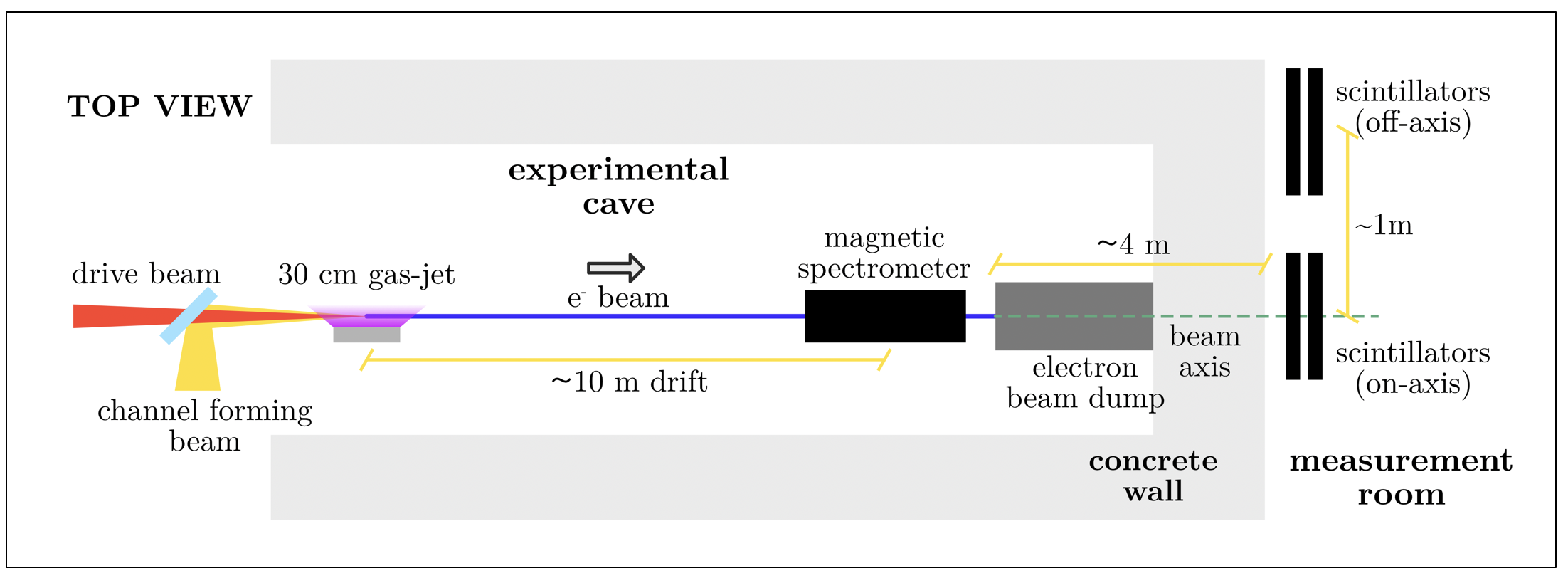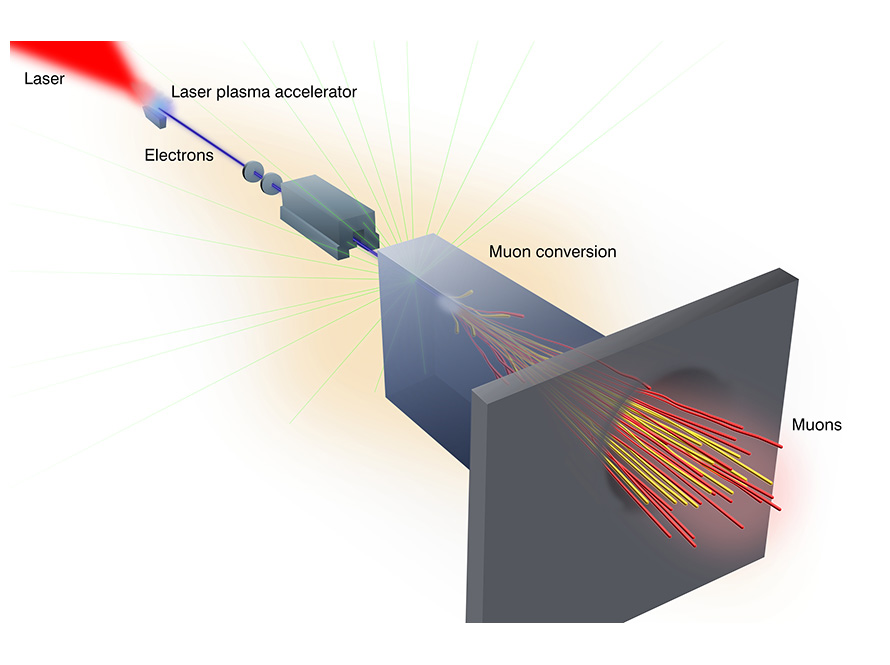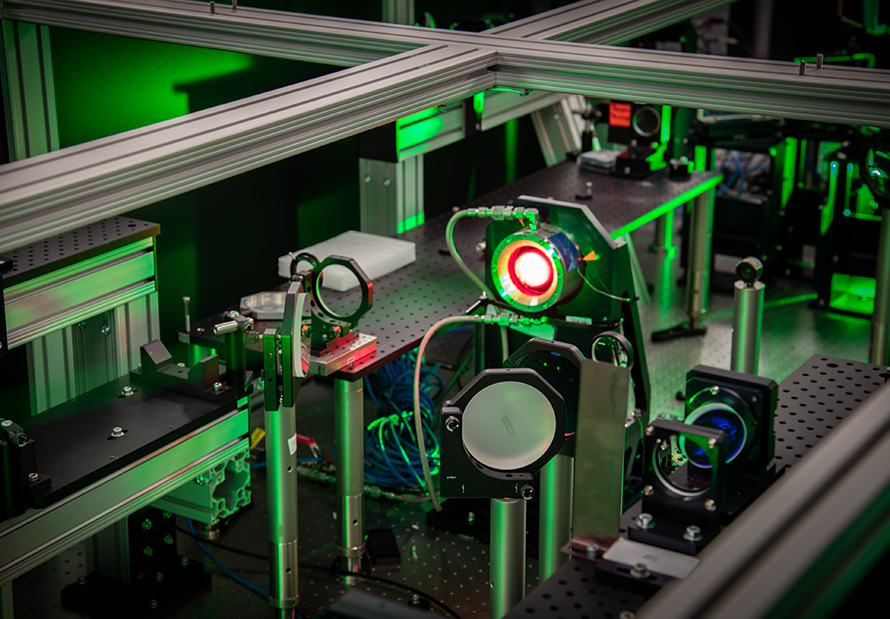Key Takeaways
- Researchers have used a laser-plasma accelerator (LPA) to create a compact source of high-energy muons that offers muon fluxes that are several orders of magnitude higher than cosmic rays.
- The research has enabled the properties of a collimated beam of muons to be analyzed and could serve as a source of highly penetrating particles for compact imaging applications.
- The technique could lay the foundations for a powerful new imaging method that surpasses the capabilities of current electron, X-ray, gamma-ray, and proton imaging technologies.
New research, led by scientists and engineers from the U.S. Department of Energy’s Lawrence Berkeley National Laboratory (Berkeley Lab) and their collaborators, has used an advanced particle accelerator called a laser-plasma accelerator (LPA) to generate a collimated beam of high-energy muons.
The work, led by researchers from Berkeley Lab’s Accelerator Technology & Applied Physics (ATAP) Division and Physics Division, in collaboration with colleagues from the University of California, Berkeley, and the University of Maryland, could provide a compact muon source for scientific research and advanced imaging technologies for detecting hazardous, radioactive, and explosive materials, and for penetrating deep into mountains and underground structures like mines and bunkers.
While the physics of muon production “is well understood,” says Davide Terzani, a research scientist at ATAP’s Berkeley Lab Laser Accelerator (BELLA) Center and lead author of the paper, this is “the first reported source of multi-GeV muons from an LPA-generated electron driver that has been characterized for its potential as a compact source of high-flux, directional, deeply-penetrating muons for a future portable imaging technology.”
“This research demonstrates a compact, directional source of muons with much greater intensity than cosmic rays,” says ATAP Division Director Cameron Geddes. “Because muons penetrate where other methods can’t, this opens new opportunities for mineral discovery, sensing, and other applications.”
A compact muon source
Muons are naturally occurring fundamental particles. Many are created when high-energy cosmic rays strike Earth’s atmosphere. Although they carry the same electric charge as electrons, muons are about 200 times heavier, making them much more penetrating than electrons, X-rays, gamma rays, or protons. This allows them to pass through large structures of solid rock or concrete walls that are tens to hundreds of meters thick, making them ideal for advanced imaging.
For example, muon imaging can be used to detect ore bodies, such as metal-rich mineral deposits, whose densities contrast significantly with those of the surrounding host rock. An active source of mobile, directional muons could therefore be used to map new mineral deposits, as well as identify extensions to existing ore bodies.
However, naturally occurring muons mainly reach the Earth’s surface from a vertical direction, which restricts imaging to a top-to-bottom view of an object. They also arrive in such small numbers that it takes months of exposure to form an image. These limitations reduce their usefulness as an imaging tool.

While high-intensity muon beams can be generated in laboratories through proton collisions, such as those conducted in the Muon g-2 experiment at the Fermi National Accelerator Laboratory (Fermilab), which produce short-lived particles called mesons that decay into muons, this method requires large and costly accelerator complexes, making them “impractical for applications requiring a portable muon source,” says Terzani.
Muons can also be produced when high-energy electrons pass through a solid converter target and slow down as they interact with the electric fields of atomic nuclei. This causes the electrons to emit high-energy photons, known as Bremsstrahlung (or braking radiation). If these photons have enough energy, they can interact with nuclei to produce particle–antiparticle pairs, including muon–antimuon pairs. However, the electron beam energy must be sufficiently high for the resulting muons to escape the converter target. So far, this has resulted in low muon yields.
Next-generation particle accelerators, such as LPAs, can now produce GeV-scale electron beams with much smaller setups than traditional accelerators. For example, researchers at the BELLA Center recently demonstrated that an LPA can accelerate electron beams to 10 GeV energies in just 30 centimeters. When these electron beams strike a solid target, they can generate photons with sufficient energy to produce muon beams through a process known as pair production.


These muons can have energies comparable to the initial electron beam, and simulations at BELLA indicate that a 10-GeV electron beam can generate pair-produced muons with energies up to about 10 GeV. These muons are also characterized by low divergence, confined to a narrow cone, and strong directionality, following the electron beam path, with yields that are orders of magnitude higher than those produced by cosmic rays.
These characteristics make them exceptionally well-suited for imaging applications “because they enable the illumination of the target to be optimized and allow tracking the trajectory of individual muons before and after the target,” explains Terzani. Furthermore, because the energy and number of pair-produced muons scale with the initial electron beam energy and charge, they can be adjusted to fit specific applications.
To generate muons, the team used the BELLA Petawatt laser facility to produce high-energy, ultrafast laser pulses. These pulses were fired into a 30-cm-long hydrogen gas jet containing a nitrogen dopant, which created a plasma that accelerated electron bunches, generated through a technique known as ionization injection to very high energies up to 10 GeV. These highly focused electron beams were then directed at a solid converter target, commonly referred to as a beam dump.
Constructed with 40.5 cm of lead and 1 m of steel, encased in a 1.8-m concrete block, this beam dump absorbs all secondary particles except muons. According to Terzani, this lowers the risk of radiation leaks, ensuring that the experiments are conducted safely.
Detecting muons
The next challenge the researchers faced was figuring out how to detect their LPA-generated muons.
Along with the muons, high-energy electrons passing through the beam dump create a significant amount of secondary radiation, which can interfere with the detectors’ ability to distinguish muons from background noise.
Fortunately, notes Terzani, the Physics and Nuclear Science Divisions at Berkeley Lab have extensive experience in developing particle detectors and “helped us look for the muon decay time, which is a signature that a muon has been detected.”
To achieve this, the team used detectors made of materials that emit light when a charged particle, such as a muon, passes through. These scintillator detectors collect and convert the emitted light into electrical signals with photomultiplier tubes. This method enabled precise timing and tracking of the muons, allowing them to measure their energy.
“Whenever we detected a pair of signals with a time delay that matched the muon decay time, we had clear proof that we had recorded the passage of a muon,” says Terzani.
During a two-hour experimental period at the reduced repetition rate of the BELLA PW facility, the researchers successfully identified a total of 126 muons. Moreover, these results aligned closely with numerical simulations. To perform these simulations, the researchers used custom code based on the Geant4 toolkit to model the interaction of high-energy electrons with the beam dump and to estimate muon production rates.

Muon flux behind the concrete wall computed using Geant4 for a perfectly aligned beam. The calculation assumes an initial Q = 80 pC electron beam perfectly aligned with the ideal beam’s reference axis, i.e., it does not interact with metal parts in the laser diagnostics and the magnetic spectrometer chassis. The muon flux at x = 0, y = −0.45m is F = 73.5 ± 9.1m−2shot−1. An inspection of the muons shows that all of them are generated via Bethe-Heitler. The detection plane is ≃ 4m downstream from the muon source.
The simulations also included muons produced from meson decay, which occur when Bremsstrahlung photons interact with background protons, neutrons, and nucleons in the target, as well as various scenarios such as well-aligned and misaligned electron beams. They also accounted for the effects of angular fluctuations observed during the experiment.
This strong agreement between experimental results and simulations, “not only validated the accuracy of our computational models,” says Terzani, “but also reinforced the reliability of the LPA-driven muon production method.”
He notes that these LPA-generated muons can produce muon fluxes much higher than those from cosmic rays, which decreases the exposure time needed for imaging. They can also be directed in various orientations, allowing objects to be imaged from different angles.
“With the appropriate advancements in laser technology, this muon source could be operated by a movable system that can be deployed at the imaging site,” says Terzani.
The team plans to measure the flux and spectrum of the muon beam using a different detection system based on ultra-fast particle trackers. However, this will require careful shielding of the detector, which he says is a challenge they can now address “thanks to the results we achieved in this work.”
The research presented here was supported by funding from the U.S. Department of Defense’s Defense Advanced Research Projects Agency and the U.S. Department of Energy Office of Science, Office of High Energy Physics.
To learn more…
Davide Terzani, Stanimir Kisyov, Stephen Greenberg, Luc Le Pottier, Maria Mironova, Alex Picksley, Joshua Stackhouse, Hai-En Tsai, Raymond Li, Ela Rockafellow, Bo Miao, Jaron E. Shrock, Timon Heim, Maurice Garcia-Sciveres, Carlo Benedetti, John Valentine, Howard M. Milchberg, Kei Nakamura, Anthony J. Gonsalves, Jeroen van Tilborg, Carl B. Schroeder, Eric Esarey, and Cameron G. R. Geddes. “Measurement of directional muon beams generated at the Berkeley Lab Laser Accelerator,” Phys. Rev. Accel. Beams 28, 103401 (2025). https://doi.org/10.1103/kxjr-h7zs
For more information on ATAP News articles, contact caw@lbl.gov
